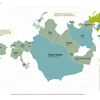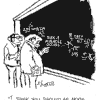24.4.2008 | 18:50
Sorry to ruin the fun, but an ice age cometh
Phil Chapman | April 23, 2008
THE scariest photo I have seen on the internet is www.spaceweather.com, where you will find a real-time image of the sun from the Solar and Heliospheric Observatory, located in deep space at the equilibrium point between solar and terrestrial gravity.
What is scary about the picture is that there is only one tiny sunspot.
Disconcerting as it may be to true believers in global warming, the average temperature on Earth has remained steady or slowly declined during the past decade, despite the continued increase in the atmospheric concentration of carbon dioxide, and now the global temperature is falling precipitously.
All four agencies that track Earth's temperature (the Hadley Climate Research Unit in Britain, the NASA Goddard Institute for Space Studies in New York, the Christy group at the University of Alabama, and Remote Sensing Systems Inc in California) report that it cooled by about 0.7C in 2007. This is the fastest temperature change in the instrumental record and it puts us back where we were in 1930. If the temperature does not soon recover, we will have to conclude that global warming is over.
There is also plenty of anecdotal evidence that 2007 was exceptionally cold. It snowed in Baghdad for the first time in centuries, the winter in China was simply terrible and the extent of Antarctic sea ice in the austral winter was the greatest on record since James Cook discovered the place in 1770.
It is generally not possible to draw conclusions about climatic trends from events in a single year, so I would normally dismiss this cold snap as transient, pending what happens in the next few years.
This is where SOHO comes in. The sunspot number follows a cycle of somewhat variable length, averaging 11 years. The most recent minimum was in March last year. The new cycle, No.24, was supposed to start soon after that, with a gradual build-up in sunspot numbers.
It didn't happen. The first sunspot appeared in January this year and lasted only two days. A tiny spot appeared last Monday but vanished within 24 hours. Another little spot appeared this Monday. Pray that there will be many more, and soon.
The reason this matters is that there is a close correlation between variations in the sunspot cycle and Earth's climate. The previous time a cycle was delayed like this was in the Dalton Minimum, an especially cold period that lasted several decades from 1790.
Northern winters became ferocious: in particular, the rout of Napoleon's Grand Army during the retreat from Moscow in 1812 was at least partly due to the lack of sunspots.
That the rapid temperature decline in 2007 coincided with the failure of cycle No.24 to begin on schedule is not proof of a causal connection but it is cause for concern.
It is time to put aside the global warming dogma, at least to begin contingency planning about what to do if we are moving into another little ice age, similar to the one that lasted from 1100 to 1850.
There is no doubt that the next little ice age would be much worse than the previous one and much more harmful than anything warming may do. There are many more people now and we have become dependent on a few temperate agricultural areas, especially in the US and Canada. Global warming would increase agricultural output, but global cooling will decrease it.
Millions will starve if we do nothing to prepare for it (such as planning changes in agriculture to compensate), and millions more will die from cold-related diseases.
There is also another possibility, remote but much more serious. The Greenland and Antarctic ice cores and other evidence show that for the past several million years, severe glaciation has almost always afflicted our planet.
The bleak truth is that, under normal conditions, most of North America and Europe are buried under about 1.5km of ice. This bitterly frigid climate is interrupted occasionally by brief warm interglacials, typically lasting less than 10,000 years.
The interglacial we have enjoyed throughout recorded human history, called the Holocene, began 11,000 years ago, so the ice is overdue. We also know that glaciation can occur quickly: the required decline in global temperature is about 12C and it can happen in 20 years.
The next descent into an ice age is inevitable but may not happen for another 1000 years. On the other hand, it must be noted that the cooling in 2007 was even faster than in typical glacial transitions. If it continued for 20 years, the temperature would be 14C cooler in 2027.
By then, most of the advanced nations would have ceased to exist, vanishing under the ice, and the rest of the world would be faced with a catastrophe beyond imagining.
Australia may escape total annihilation but would surely be overrun by millions of refugees. Once the glaciation starts, it will last 1000 centuries, an incomprehensible stretch of time.
If the ice age is coming, there is a small chance that we could prevent or at least delay the transition, if we are prepared to take action soon enough and on a large enough scale.
For example: We could gather all the bulldozers in the world and use them to dirty the snow in Canada and Siberia in the hope of reducing the reflectance so as to absorb more warmth from the sun.
We also may be able to release enormous floods of methane (a potent greenhouse gas) from the hydrates under the Arctic permafrost and on the continental shelves, perhaps using nuclear weapons to destabilise the deposits.
We cannot really know, but my guess is that the odds are at least 50-50 that we will see significant cooling rather than warming in coming decades.
The probability that we are witnessing the onset of a real ice age is much less, perhaps one in 500, but not totally negligible.
All those urging action to curb global warming need to take off the blinkers and give some thought to what we should do if we are facing global cooling instead.
It will be difficult for people to face the truth when their reputations, careers, government grants or hopes for social change depend on global warming, but the fate of civilisation may be at stake.
In the famous words of Oliver Cromwell, "I beseech you, in the bowels of Christ, think it possible you may be mistaken."
Phil Chapman is a geophysicist and astronautical engineer who lives in San Francisco. He was the first Australian to become a NASA astronaut.
http://www.theaustralian.news.com.au/story/0,25197,23583376-5013480,00.html
Um bloggiš
Baldur Fjölnisson
Nżjustu fęrslur
- Torfi Stefįns bannašur ęvilangt
- OL ķ skįk. Landinn malaši Kenķu ķ 9. umferš
- OL ķ skįk: Landinn ķ 88. sęti eftir 8 umferšir
- Mešaljónar ķ skįkinni
- Baggalśtur - Sagan af Jesśsi
- Eitraš fyrir lżšnum?
- Óvenjulega döpur taflmennska innfęddra einkennir Reyjavķkursk...
- U.S. Rushes Coolant to Japanese Nuke Plant After Earthquake
Heimsóknir
Flettingar
- Ķ dag (30.4.): 0
- Sl. sólarhring: 1
- Sl. viku: 5
- Frį upphafi: 0
Annaš
- Innlit ķ dag: 0
- Innlit sl. viku: 3
- Gestir ķ dag: 0
- IP-tölur ķ dag: 0
Uppfęrt į 3 mķn. fresti.
Skżringar
Bloggvinir
-
 Agný
Agný
-
 Alfreð Símonarson
Alfreð Símonarson
-
 Andrea J. Ólafsdóttir
Andrea J. Ólafsdóttir
-
 Bjarni Harðarson
Bjarni Harðarson
-
 Bjarni Kjartansson
Bjarni Kjartansson
-
 Björgvin Gunnarsson
Björgvin Gunnarsson
-
 Brynjar Jóhannsson
Brynjar Jóhannsson
-
 FLÓTTAMAÐURINN
FLÓTTAMAÐURINN
-
 Eygló Þóra Harðardóttir
Eygló Þóra Harðardóttir
-
 FreedomFries
FreedomFries
-
 Fríða Eyland
Fríða Eyland
-
 Félag um stafrænt frelsi á Íslandi
Félag um stafrænt frelsi á Íslandi
-
 Georg P Sveinbjörnsson
Georg P Sveinbjörnsson
-
 Gestur Guðjónsson
Gestur Guðjónsson
-
 Gils N. Eggerz
Gils N. Eggerz
-
 Gullvagninn
Gullvagninn
-
 Gunnar Skúli Ármannsson
Gunnar Skúli Ármannsson
-
 Guðrún María Óskarsdóttir.
Guðrún María Óskarsdóttir.
-
 Gísli Hjálmar
Gísli Hjálmar
-
 Hagbarður
Hagbarður
-
 Halla Rut
Halla Rut
-
 Haraldur Haraldsson
Haraldur Haraldsson
-
 Hilmar Kári Hallbjörnsson
Hilmar Kári Hallbjörnsson
-
 Hlekkur
Hlekkur
-
 Ingibjörg Álfrós Björnsdóttir
Ingibjörg Álfrós Björnsdóttir
-
 Jens Guð
Jens Guð
-
 Jóhannes Ragnarsson
Jóhannes Ragnarsson
-
 Jón Aðalsteinn Jónsson
Jón Aðalsteinn Jónsson
-
 Jón Ragnarsson
Jón Ragnarsson
-
 Jón Steinar Ragnarsson
Jón Steinar Ragnarsson
-
 Jónína Benediktsdóttir
Jónína Benediktsdóttir
-
 Karl Tómasson
Karl Tómasson
-
 Kári Magnússon
Kári Magnússon
-
 Loopman
Loopman
-
 Magnús Þór Hafsteinsson
Magnús Þór Hafsteinsson
-
 Promotor Fidei
Promotor Fidei
-
 Rúnar Sveinbjörnsson
Rúnar Sveinbjörnsson
-
 Salvör Kristjana Gissurardóttir
Salvör Kristjana Gissurardóttir
-
 Sandra María Sigurðardóttir
Sandra María Sigurðardóttir
-
 SeeingRed
SeeingRed
-
 Sigurbjörn Friðriksson
Sigurbjörn Friðriksson
-
 Sigurjón Þórðarson
Sigurjón Þórðarson
-
 Sigurður Þórðarson
Sigurður Þórðarson
-
 Snorri Hrafn Guðmundsson
Snorri Hrafn Guðmundsson
-
 el-Toro
el-Toro
-
 Sveinn Ingi Lýðsson
Sveinn Ingi Lýðsson
-
 Tryggvi Hjaltason
Tryggvi Hjaltason
-
 TómasHa
TómasHa
-
 Túrilla
Túrilla
-
 Upprétti Apinn
Upprétti Apinn
-
 gudni.is
gudni.is
-
 haraldurhar
haraldurhar
-
 proletariat
proletariat
-
 Ívar Pálsson
Ívar Pálsson
-
 Ómar Ragnarsson
Ómar Ragnarsson
-
 Ónefnd
Ónefnd
-
 Óskar
Óskar
-
 Óskar Helgi Helgason
Óskar Helgi Helgason
-
 Óskar Þ. G. Eiríksson
Óskar Þ. G. Eiríksson
-
 Þórir Kjartansson
Þórir Kjartansson
-
 Arnar Guðmundsson
Arnar Guðmundsson
-
 Bara Steini
Bara Steini
-
 Birgir R.
Birgir R.
-
 Birgir Rúnar Sæmundsson
Birgir Rúnar Sæmundsson
-
 brahim
brahim
-
 Brosveitan - Pétur Reynisson
Brosveitan - Pétur Reynisson
-
 Bwahahaha...
Bwahahaha...
-
 Dingli
Dingli
-
 eysi
eysi
-
 Gestur Kristmundsson
Gestur Kristmundsson
-
 Guðbjörg Elín Heiðarsdóttir
Guðbjörg Elín Heiðarsdóttir
-
 Gunnar Helgi Eysteinsson
Gunnar Helgi Eysteinsson
-
 Gunnar Rögnvaldsson
Gunnar Rögnvaldsson
-
 Helgi Jóhann Hauksson
Helgi Jóhann Hauksson
-
 Hlini Melsteð Jóngeirsson
Hlini Melsteð Jóngeirsson
-
 Jakobína Ingunn Ólafsdóttir
Jakobína Ingunn Ólafsdóttir
-
 Katrín Snæhólm Baldursdóttir
Katrín Snæhólm Baldursdóttir
-
 kreppukallinn
kreppukallinn
-
 Kristín Magdalena Ágústsdóttir
Kristín Magdalena Ágústsdóttir
-
 Máni Ragnar Svansson
Máni Ragnar Svansson
-
 Morgunblaðið
Morgunblaðið
-
 Neo
Neo
-
 Orgar
Orgar
-
 Ragnar L Benediktsson
Ragnar L Benediktsson
-
 Rauði Oktober
Rauði Oktober
-
 Skákfélagið Goðinn
Skákfélagið Goðinn
-
 Sveinn Þór Hrafnsson
Sveinn Þór Hrafnsson
-
 Vilhjálmur Árnason
Vilhjálmur Árnason
-
 Þór Ludwig Stiefel TORA
Þór Ludwig Stiefel TORA




Athugasemdir
Žar fór kenningin um gróšurhśsaįhrifin.... ęttli Al Gore verši žį atvinnulaus?
Viš erum sem sagt hįš duttlungum sólarinnar eftir allt saman....
gfs (IP-tala skrįš) 24.4.2008 kl. 20:44
Sólin er aš sjįlfsögšu undirstaša alls lķfs į jöršinni og virkni hennar er ekki alveg stöšug frekar en annaš ķ nįttśrunni. Ašeins smįvęgilegt frįvik ķ virkni hennar getur haft veruleg įhrif hér į jöršinni.
http://www.rt.is/ahb/sol/
"The important thing is to not stop questioning." - Albert Einstein
Baldur Fjölnisson, 25.4.2008 kl. 16:21
Bęta viš athugasemd [Innskrįning]
Ekki er lengur hęgt aš skrifa athugasemdir viš fęrsluna, žar sem tķmamörk į athugasemdir eru lišin.